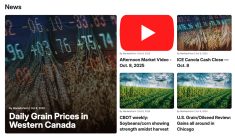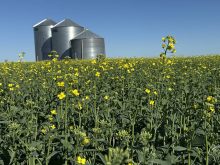This cattle market information is selected from the weekly report from Canfax, a division of the Canadian Cattlemen’s Association. More market information, analysis and statistics are available by becoming a Canfax subscriber by calling 403-275-5110 or at www.canfax.ca.
Fed prices firm
Alberta direct cattle sales saw moderate trade last week and average prices firmed $3.50 per hundredweight higher than the previous week. Prices were the highest seen since the end of July.
Read Also

Huge Black Sea flax crop to provide stiff competition
Russia and Kazakhstan harvested huge flax crops and will be providing stiff competition in China and the EU.
Most of last week’s trade was reported dressed from $244-$246 per cwt. delivered and cattle are being scheduled for mid-October delivery.
Rail prices generally strengthened $5.50 per cwt. higher than the previous week. Western Canadian fed slaughter for the week ending Sept. 15 rebounded 14 percent larger to 42,880 head. Year-to-date western fed slaughter is six percent larger at 1,380,265 head. Canadian weekly slaughter has only dipped below 50,000 head four times so far this year, and including last week, has exceeded 60,000 head 11 times.
Canadian steer carcass weights for the week ending Sept. 15 were six pounds heavier than the previous week and nine lb. larger than a year ago at 922 lb.
Canadian fed/cow exports to the United States for the week ending Sept. 8 surged to 9,069 head and year to date totaled 252,220 head. It was the third largest weekly export volume this year.
In the outlook, feedlot supplies are expected to moderate but carcass weights should seasonally trend larger. The large harvest will continue next week and one major packer is now routinely killing six days a week.
In the U.S., trade mostly developed in the north on Sept. 20-21 with live prices reported from US$110-$111 per cwt., fully steady with the previous week.
Dressed sales Sept. 20 were fully steady with the top end of the previous week at $175 per cwt. delivered. Trade in the South developed at $111 per cwt., also fully steady.
Stockers and feeder cattle traded fully steady to $6 per cwt. higher than the previous week. Corn firmed modestly last week on improved global demand and some concerns over heavy rains and flowing in some areas.
Cows at new low
Prices for D2 cows established new annual lows, trading $1.75 lower to average C$83.83. The D3s traded in a range of $68-$81 to average $74.67.
Cow prices have not been this low since November 2016. The point of concern is non-fed volumes through commercial auction facilities have been fairly light and seasonally larger supplies are still ahead.
Over the past two weeks, butcher bull prices are higher than last year. Over the past 15 years, D2 cow prices have never established second half lows during September, suggesting further downside risk is possible into the fourth quarter.
Weaker cow prices have been noted in the U.S. as well. Mid-September U.S. canner and utility prices are trading at the lowest level since 2010. Larger cow slaughter volumes in the U.S. have pressured the 90 percent trim market.
Calf market steady
The best word to describe the western Canadian calf market has been “steady” as 550 lb. steers have traded on either side of $225 per cwt. for the better part of this year.
Even though the calf prices have not shown much in terms of seasonality, prices have been trending right in line with the five-year average. On the electronics, heifers with no replacements kept back are trading roughly $24-$25 per cwt. back of their steer mates, while groups of heifers with replacements pulled out are selling around $30-$33 per cwt. back of their steer counterparts.
Alberta 900 lb. steers for January delivery have seen bids and sales in the low $190s per cwt., f.o.b. the feedlot. Using a 10-cent slide, cash-to-futures basis levels are around $1.15 per cwt. It should be noted 850 lb. steer basis levels for January 2018 averaged -$1.29 per cwt.
With U.S. corn being freighted into southern Alberta and supplies of corn being booked out as far as spring of 2019, barley prices have come under pressure. Harvest delays and quality concerns could add additional wheat to the feed market. Malt and feed barley prices remain comparable, suggesting we could see malt barley sold as feed.
In the outlook, African Swine Fever continues to spread in China and Europe. China has more than half the world’s hog population and the only way to stop the spread of this disease is mass culling. This might not necessarily have a direct impact on the feeder market but it could be a game changer on the protein and export markets supporting both live and lean hog futures.
Select price lower
U.S. cut-out values traded mixed this week as the United States Department of Agriculture reported light to moderate demand and a moderate to heavy offering. The Choice cut-out value was up slightly to US$204.52, compared to $204.04 the previous week. Select traded at $194.91, down from the previous week’s average of $197.24.
U.S. steer carcass weights for the week ending Sept. 8 were eight lb. heavier than the previous week and steady with the same week last year.
















